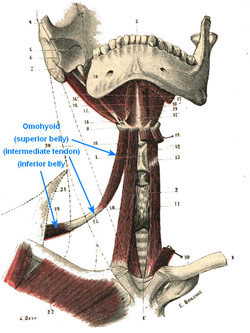
Omohyoid muscle.
Click on the image for a larger depiction
The omohyoid also known as the musculus omohyoideus is the most lateral of the infrahyoid muscles, the others being the sternohyoid, sternothyroid, and thyroid muscles.The omohyoid is a long muscle formed by two muscular bellies (superior and inferior) and an intermediate tendon.
The inferior belly originates from the superior margin of the scapula, near the superior transverse ligament of the scapula. Sometimes, as a variation, the tendon of the inferior belly originates directly from this ligament. The inferior belly passes medially, posteriorly, and slightly superiorly towards the intermediate tendon. The medial aspect of this belly is deep to the trapezius muscle.
The intermediate tendon is held in place by a strong extension of the middle layer of the cervical fascia. This extension has firm attachments to the first rib and the posterior surface of the clavicle.
Along with the other infrahyoid muscles, the omohyoid muscle depresses the hyoid bone. Each belly receives a separate branch that arises from the ansa cervicalis (C1, C2, and C3).
Note: The image in this article was taken from the book "Tratado de Anatomía Humana" by Testut and Latarjet. The illustration was made by George Devy, a famous French painter who specialized in anatomical illustrations (? -1902) and the engraving was made by a Swiss artist, Edmond Boulenaz (1859-1905). This image is in the Public Domain and has been edited by us.
Sources:
1. “Gray’s Anatomy” Henry Gray, 1918
2. "Tratado de Anatomia Humana" Testut et Latarjet 8th Ed. 1931 Salvat Editores, Spain
3. "Gray's Anatomy" 42nd British Ed. Churchill Livingstone 2021
4. “An Illustrated Atlas of the Skeletal Muscles” Bowden, B. 4th Ed. Morton Publishing. 2015
5. "Trail Guide to The Body" 4th. Ed. Biel, A. Books of Discovery. 2010
6. "Petite histoire de l'iconographie anatomique" Huard, P; Imbalt-Huart, MJ Communication présentée à la Société Française d'Histoire de la Médecine, le30 septembre 1972.
7. https://www.anatomicalterms.info



